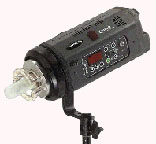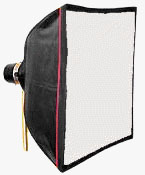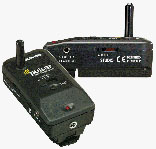There are basically two types of studio lighting - tungsten photoflood and studio flash. Photofloods are the least expensive approach as they are basically just powerful versions of domestic lamps. They have the advantage that the combined effect of a number of lights is easily observed. Unfortunately they also produce lots of heat and glare, and can make the working environment uncomfortable.
Studio flash units are large and very powerful manually controlled flash heads mounted on stands. They can be equipped with a range of devices to control the direction, colour, focus and softness of the light. The most common attachments are the softbox and the umbrella reflector, both of which diffuse and direct the light source. Better units also have integral modelling lamps that facilitate set-up by simulating the effects of the flash.
Even basic studio equipment is specialized and relatively expensive. It includes:
- a pair of studio flash heads;
- adjustable stands;
- a softbox;
- an umbrella reflector;
- synchronization cables or remote trigger devices;
- supplementary reflectors and absorbers;
- background stands and support bar;
- background paper or fabric;
- a flash-meter; and
- props such as stools, seats, and cushions to position subjects.

 Numerous flash heads can be used in a single lighting setup, but control becomes increasingly difficult as each flash-head in added. Excellent work can be done with a single flash-head and a reflector, but two heads are commonly used. One is used as the principal source, and the other as fill to control shadows and reduce contrast. A third head is typically added as a hair light to put backlit highlights in the subject's hair. A hair lights is normally suspended from a balanced extendable boom, and hence requires an additional stand. The unit shown on the right is a typical flash-head with an exposed flash tube. A softbox, umbrella or simple reflector is normally attached to a collar around the flash tube. Most modern flash-heads contain their own power supplies and hence plug directly into the mains supply. Simple manual controls vary the flash output and a modelling light, seen in the centre of the flash tube, provides a preview of the effectiveness of the lighting setup prior to exposure. The flash-heads also have an adjustable bracket for convenient and flexible attachment to a variable-height tripod stand.
Numerous flash heads can be used in a single lighting setup, but control becomes increasingly difficult as each flash-head in added. Excellent work can be done with a single flash-head and a reflector, but two heads are commonly used. One is used as the principal source, and the other as fill to control shadows and reduce contrast. A third head is typically added as a hair light to put backlit highlights in the subject's hair. A hair lights is normally suspended from a balanced extendable boom, and hence requires an additional stand. The unit shown on the right is a typical flash-head with an exposed flash tube. A softbox, umbrella or simple reflector is normally attached to a collar around the flash tube. Most modern flash-heads contain their own power supplies and hence plug directly into the mains supply. Simple manual controls vary the flash output and a modelling light, seen in the centre of the flash tube, provides a preview of the effectiveness of the lighting setup prior to exposure. The flash-heads also have an adjustable bracket for convenient and flexible attachment to a variable-height tripod stand.
Stands are normally of a collapsible tripod design, and have an extendable central column which can be used to raise a flash-head as high as a photographer can reach. Such stands are required in considerable numbers. They are used to support most but not all flash-heads, and may also be used to support background equipment.

 Flash-heads produce hard, direct light that generates harsh shadows and hence extreme contrast. Portraits taken with naked flash-heads tend to exhibit ugly shadows on the subject's face and on the background. Softboxes and umbrella reflectors are used to diffuse and soften the light, producing more gradual transitions between light and shade. Numerous sizes and types are available for a range of specific applications. However, the larger sizes are generally more effective because they provide a larger light source and hence softer light.
Flash-heads produce hard, direct light that generates harsh shadows and hence extreme contrast. Portraits taken with naked flash-heads tend to exhibit ugly shadows on the subject's face and on the background. Softboxes and umbrella reflectors are used to diffuse and soften the light, producing more gradual transitions between light and shade. Numerous sizes and types are available for a range of specific applications. However, the larger sizes are generally more effective because they provide a larger light source and hence softer light.
Flash-heads may be triggered in a number of ways. The most basic system uses a simple synchronization lead to connect the camera to the flash unit. Most flash-heads contain photoelectric cells which detect flashes from a master unit and trigger themselves without the need synchronization cables between multiple units. The disadvantage of the synchronization cable system is that it restricts the movement of the photographer and the cable becomes entangled with all the other studio equipment. Models may also trip on the trailing wires. Some photographers use a small camera-mounted flashgun to trigger all the studio units. However, this is somewhat unreliable because it is largely a line-of-sight system. The best system is a radio trigger because it is reliable and not dependent upon line of sight. Simple units are relatively inexpensive and can be plugged directly in to cameras and standard flash-heads.
Flash-meters are essential in a studio environment. These are designed specifically to measure precisely the combined output of multiple flash-heads, and provide an instant exposure reading. They are also equipped with a socked for a synchronization lead so that the user can move to any location in the lighting setup, trigger the flash-heads directly from the meter, and obtain a series of local exposure measurements.
 Supplementary reflectors and absorbers are usually basic sheets of reflecting or absorbing material such as white polystyrene of black cardboard. These are useful for increasing or decreasing the quantity of light falling in to a particular part of a lighting setup. White polystyrene is highly reflective, and the degree of fill provided can be controlled by varying the distances between the reflecting surface, the light source and the subject. Black absorbers reflect almost no light and may therefore be used to prevent light reaching particular areas.
Supplementary reflectors and absorbers are usually basic sheets of reflecting or absorbing material such as white polystyrene of black cardboard. These are useful for increasing or decreasing the quantity of light falling in to a particular part of a lighting setup. White polystyrene is highly reflective, and the degree of fill provided can be controlled by varying the distances between the reflecting surface, the light source and the subject. Black absorbers reflect almost no light and may therefore be used to prevent light reaching particular areas.
 Background systems are discussed under the relevant tab within this studio section, but a basic system consists of a pair of adjustable stands, an extendable support bar, and a roll of background paper or a suitable fabric backdrop. Some fabric background systems are self-supporting.
Background systems are discussed under the relevant tab within this studio section, but a basic system consists of a pair of adjustable stands, an extendable support bar, and a roll of background paper or a suitable fabric backdrop. Some fabric background systems are self-supporting.
The range of props required in a basic studio setup depends to a large extent upon the type of work to be undertaken. However, for photographing people individually or in small groups, numerous posing tubs, low stools and fabric-covered boxes are useful. These can be made reasonably easily from basic materials, or purchased in sets of various sizes.






